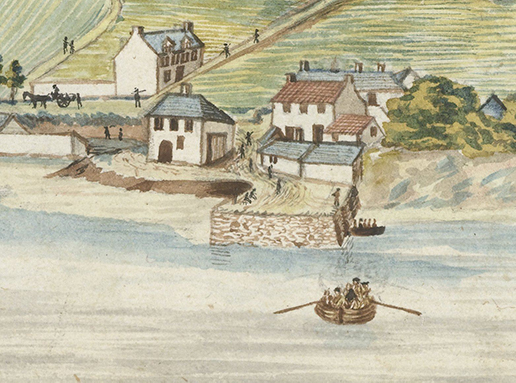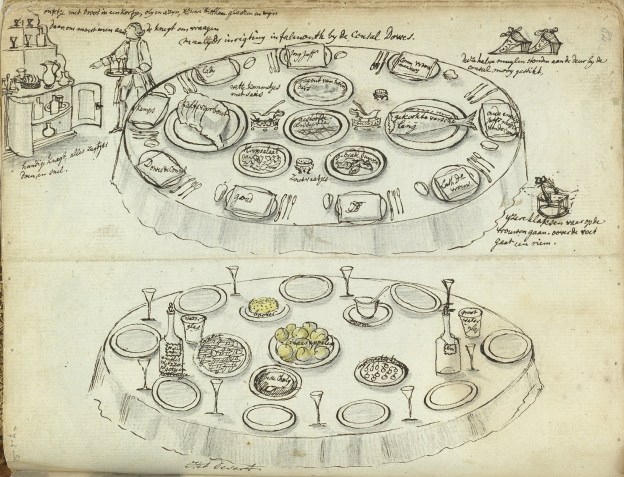Early in the summer of 1778, Jan Brandes embarked on the Dutch East Indiaman Holland, bound for Indonesia. He was a 36-year-old Dutch Lutheran pastor who had been posted to Batavia, and he brought his sketchbook with him on the voyage.
The Holland sailed from the Texel on 23 May. About two weeks later the ship put in at Falmouth in Cornwall and remained there for some days, waiting for a favourable wind. Some of the passengers went ashore. There was an invitation to dinner at the house of Mr Dowe, the consul for the Dutch Republic, and Brandes recorded the whole thing in his sketchbook – the seating plan, the table setting and the dishes served, both main course and dessert. A monogram marks his own place, two to the right of the consul. On the consul’s left is ‘Kemps’, probably Arthur Kempe, who had served as a lieutenant in HMS Adventure on Captain James Cook’s second expedition, and would later be an admiral. To Brandes’s left is a Lutheran predikant (minister) named Goudoever and to his right is the Lutheran’s wife. At the far right facing the fish is an old English teacher who is mother of the consul, and opposite Brandes is a young teacher (I think – someone familiar with Dutch could provide more reliable translations).
A pair of embroidered shoes standing by the door catches the pastor’s attention, and he also draws a contraption worn by the women, he notes, with a strap over the foot. It’s a patten, used to keep the shoes out of the mud – although his view of ‘Strand Straat’, dated 9 June 1778 and spread across two pages, shows Market Strand neatly paved. Also visible is the sign of the King’s Arms, and beside it a mooring bollard with the bowsprit of the moored vessel just seen. Across the street is the market, and ‘Fox Schip Chandler’ with what appear to be apothecary’s jars in the window, oddly enough.
![De Strand Straat by Jan Brandes, 1778 [Rijksmuseum Amsterdam]](https://thingsturnedup.uk/wp-content/uploads/2019/06/rijk_brandes_strandstraat2_ttu.jpg?w=1024)
There were excursions. Brandes evidently crossed over to Flushing, since he drew a view from there of Green Bank Quay with two ferry boats, and what looks like a muddy country lane to get to it. The town, legal quays and custom house are beyond the edge of the drawing to the left, but Green Bank was the quay used by the Falmouth packets (which did not need customs clearance), and many of the packet commanders lived at Flushing.
![The Kai af Falmouth by Jan Brandes, 1778 [Rijksmuseum Amsterdam]](https://thingsturnedup.uk/wp-content/uploads/2019/06/rijk_brandes_greenbank_ttu.jpg?w=1024)
![Gebouw, van de Koper mijnen tusschen Penerin en Truro by Jan Brandes, 1778 [Rijksmuseum Amsterdam]](https://thingsturnedup.uk/wp-content/uploads/2019/06/rijk_brandes_coppermine_ttu.jpg?w=991)
Brandes made a quick sketch of a copper mine between Penryn and Truro, probably done during a trip he depicts as a grand cavalcade travelling to Truro by the turnpike, a journey of three hours, he notes. They are led by the consul. Behind him are ‘de Kemps’ – probably the lieutenant and his elder brother who was a clergyman. Then comes a post-chaise occupied by the predikant’s wife with the commander’s wife and daughter, and another containing the predikant and the commander of the Holland, Benjamin van der Spek. The carriages are followed by the consul’s servant on a dappled horse, then the boatswain and a midshipman. Last but one is an apprehensive-looking figure who is, I suspect, Brandes’s depiction of himself, not remotely at ease on a horse. Behind him rides the post boy, whip at the ready to keep the pastor’s horse moving.
![Ryze van Falmouth door Penerin na Truro by Jan Brandes, 1778 [Rijksmuseum Amsterdam]](https://thingsturnedup.uk/wp-content/uploads/2019/06/rijk_brandes_cavalcade_ttu.jpg)
Brandes was interested in everything he encountered, and later pages in the sketchbook are full of his observations of life in Batavia. On a page partly occupied by a view of the Channel coastline at Dover, he has added a technical diagram showing angles of heel of a ship in a storm, and below it a note about storms met with during Captain Cook’s second voyage. He must have been talking to Lieutenant Kempe.
By the happy chance of a contrary wind, Jan Brandes has left us a rare glimpse of Falmouth in its prime as the Post Office packet station serving the West Indies and America. His sketchbooks are in the Rijksmuseum, Amsterdam, and can be explored on the museum’s website.

